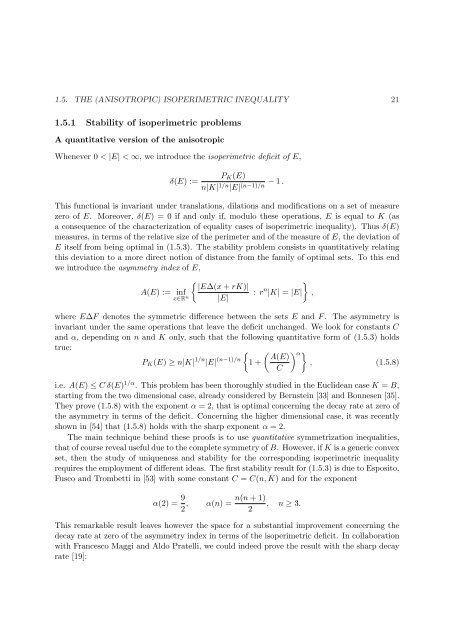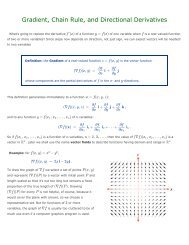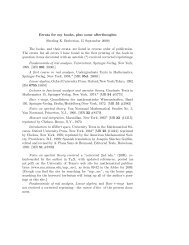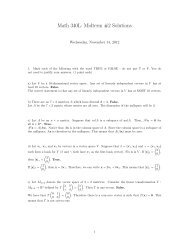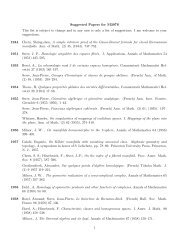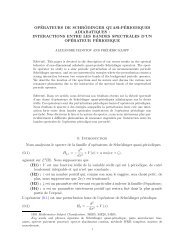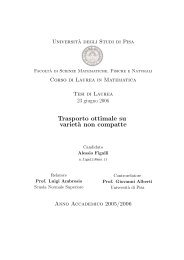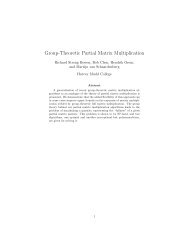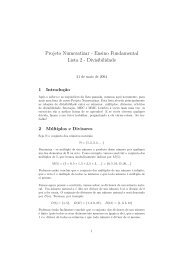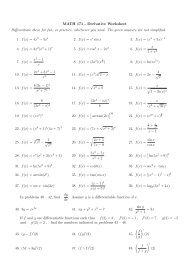Optimal transport, Euler equations, Mather and DiPerna-Lions theories
Optimal transport, Euler equations, Mather and DiPerna-Lions theories
Optimal transport, Euler equations, Mather and DiPerna-Lions theories
You also want an ePaper? Increase the reach of your titles
YUMPU automatically turns print PDFs into web optimized ePapers that Google loves.
1.5. THE (ANISOTROPIC) ISOPERIMETRIC INEQUALITY 21<br />
1.5.1 Stability of isoperimetric problems<br />
A quantitative version of the anisotropic<br />
Whenever 0 < |E| < ∞, we introduce the isoperimetric deficit of E,<br />
δ(E) :=<br />
PK(E)<br />
n|K| 1/n − 1 .<br />
|E| (n−1)/n<br />
This functional is invariant under translations, dilations <strong>and</strong> modifications on a set of measure<br />
zero of E. Moreover, δ(E) = 0 if <strong>and</strong> only if, modulo these operations, E is equal to K (as<br />
a consequence of the characterization of equality cases of isoperimetric inequality). Thus δ(E)<br />
measures, in terms of the relative size of the perimeter <strong>and</strong> of the measure of E, the deviation of<br />
E itself from being optimal in (1.5.3). The stability problem consists in quantitatively relating<br />
this deviation to a more direct notion of distance from the family of optimal sets. To this end<br />
we introduce the asymmetry index of E,<br />
A(E) := inf<br />
x∈Rn <br />
|E∆(x + rK)|<br />
|E|<br />
: r n <br />
|K| = |E| ,<br />
where E∆F denotes the symmetric difference between the sets E <strong>and</strong> F . The asymmetry is<br />
invariant under the same operations that leave the deficit unchanged. We look for constants C<br />
<strong>and</strong> α, depending on n <strong>and</strong> K only, such that the following quantitative form of (1.5.3) holds<br />
true:<br />
PK(E) ≥ n|K| 1/n |E| (n−1)/n<br />
<br />
1 +<br />
<br />
A(E)<br />
α<br />
, (1.5.8)<br />
C<br />
i.e. A(E) ≤ C δ(E) 1/α . This problem has been thoroughly studied in the Euclidean case K = B,<br />
starting from the two dimensional case, already considered by Bernstein [33] <strong>and</strong> Bonnesen [35].<br />
They prove (1.5.8) with the exponent α = 2, that is optimal concerning the decay rate at zero of<br />
the asymmetry in terms of the deficit. Concerning the higher dimensional case, it was recently<br />
shown in [54] that (1.5.8) holds with the sharp exponent α = 2.<br />
The main technique behind these proofs is to use quantitative symmetrization inequalities,<br />
that of course reveal useful due to the complete symmetry of B. However, if K is a generic convex<br />
set, then the study of uniqueness <strong>and</strong> stability for the corresponding isoperimetric inequality<br />
requires the employment of different ideas. The first stability result for (1.5.3) is due to Esposito,<br />
Fusco <strong>and</strong> Trombetti in [53] with some constant C = C(n, K) <strong>and</strong> for the exponent<br />
α(2) = 9<br />
n(n + 1)<br />
, α(n) = , n ≥ 3.<br />
2 2<br />
This remarkable result leaves however the space for a substantial improvement concerning the<br />
decay rate at zero of the asymmetry index in terms of the isoperimetric deficit. In collaboration<br />
with Francesco Maggi <strong>and</strong> Aldo Pratelli, we could indeed prove the result with the sharp decay<br />
rate [19]:


